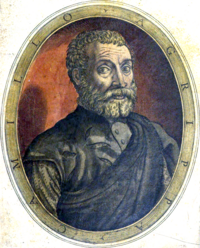|
|
You are not currently logged in. Are you accessing the unsecure (http) portal? Click here to switch to the secure portal. |
Camillo Agrippa
| Camillo Agrippa Milanese | |
|---|---|
 | |
| Born | 1510s (?) Milan, Italy |
| Died | 1595 Rome, Italy |
| Occupation | Architect Engineer |
| Influences | Achille Marozzo (?) |
| Influenced | |
| Genres | Fencing manual |
| Language | Italian |
| Notable work(s) | |
Camillo Agrippa (1510s–1595) was a 16th century Italian architect, engineer, and fencer. Born in Milan, Agrippa moved to Rome on 26 October 1535 and later became associated with the Confraternity of St. Joseph of the Holy Land. He also moved in literary and artistic circles, where he was acquainted with Cardinal Alessandro Farnese and the great artist Michelangelo.
Though he doesn't seem to have been a professional fencing master, Agrippa stands out as one of the most influential fencing theorists in history. His first treatise, titled Trattato di Scientia d'Arme, con vn Dialogo di Filosofia ("Treatise on the Science of Arms, with a Philosophical Dialogue"), was published in 1553 and presented a unique new system of swordsmanship based on his knowledge of geometry and mechanics. He expanded on these ideas in his subsequent works, published in 1575 and 1585.
Agrippa's theories revolutionized civilian fencing and presaged the emergence of the thrusting style that characterized the use of the rapier. The influence of his ideas is seen in virtually every fencing manual published in the subsequent century, including those of Ridolfo Capo Ferro da Cagli, Jerónimo Sánchez de Carranza, Salvator Fabris, and Henry de Sainct Didier.
Treatises
| Images | English Translation | Transcription
|
|---|---|---|
| Text to copy over |
Additional Resources
- Agrippa, Camillo. Fencing: A Renaissance Treatise. Ed. Ken Mondschein. New York: Italica Press, 2009. ISBN 978-1-59910-129-3
References

